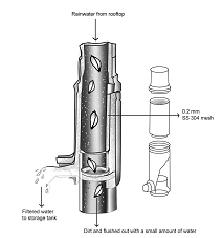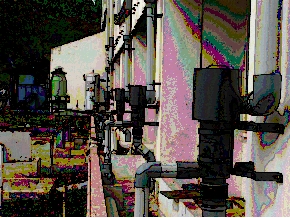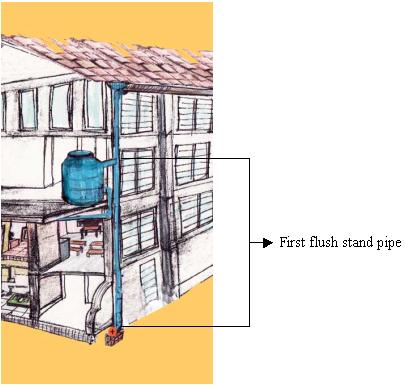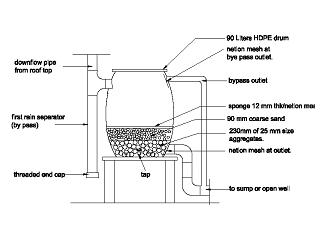It is preferable to filter the rainwater before storing it. If leaves and other organic material enter the storage tank, they decompose and support bacterial growth in the tank. Dirt and other debris, if not filtered out, can cause blocks in the plumbing system when the stored rainwater is used. Different filters exist: some are commercially available while others can be put together by you.
Care should be taken to maintain the cleanliness of the roof. It is advisable to cut tree branches that overhang on the roof. This would not only reduce the leaves, flowers, fruits and bird droppings that fall on the roof but would also reduce access to squirrels and rodents.
Filters introduce some losses into the rainwater collection system and the filter efficiency can either be calculated for simple systems or will be stated by the manufacturer.
Primary filters / leaf guards
The first level of filtration could be a grating at the outlet of the catchment or the inlet of the gutters or downtake pipes to prevent large coarse debris like leaves from entering the rainwater transportation and storage network. For open gutters, leaf guards which are usually ?” mesh screens in wire frames may be installed along the length of the gutter. The rooftop must be regularly cleaned for the leaf screens to be effective, else the piled up leaves will clog the screen and prevent rainwater from entering the gutters or downtake pipes. This can even result in leakage of water from the roof. If wire meshes or gratings are not used at the outlet of the catchment, the filtration system installed should be able to segregate such debris from the collected rainwater.
Secondary filters
The second level of filtration is required to remove finer particles and even bacteria, so that the collected rainwater is free from suspended solids and organic contaminants. Some filtering technologies are described and compared below. The final choice of a filtration system depends on the cost of the device and maintenance needs. Off-the-shelf availability is also a deciding factor since not many people will make their own filtration systems.
- Sand – gravel filter: This is a do-it-yourself filter consisting of three layers of gravel, sand and gravel, separated by meshes. The filter can be made in a ferrocement tank or in a HDPE drum. The gravel layer on top filters out the larger particles and since it has larger voids, it also acts as a store for the water as it slowly seeps through the layer of sand. The sand filters out the smaller suspended particles.
Variations to the sand –gravel filter include using a sponge layer on top to filter out coarse debris or adding a layer of charcoal or activated carbon to improve the odour.
Maintenance: The top layer of sand to a depth of about 3 cms (or sponge if used) needs to be cleaned periodically. The sand or sponge can be removed and soaked /cleaned in a bucket of water and replaced. There could be fungal growth on the sponge if prescribed maintenance is not followed. If charcoal is used, it needs to be changed every year. It is also advised to clean the meshes and the top layer of gravel.
VARUN: is a slow-sand filter constructed in a 90 litre (HDPE) drum. The lid is turned over and holes are punched in it. This is the first sieve which keeps out large leaves, twigs etc. Rainwater coming out of the lid sieve then passes
through three layers of sponge and a 150 mm thick layer of coarse sand. The filter removes suspended solids from the harvested rainwater. It has been developed by S Vishwanath, a Bangalore based water harvesting expert. According to him, from a decently clean roof 'VARUN' can handle a 50 mm per hour intensity rainfall from a 50 square metre roof area. Based on these calculations, when a rainwater harvestingsystem is being designed for a new house, the optimal number of filters can be recommended.
Maintenance: The sponge needs to be cleaned periodically and the top layer of sand to a depth of about 3 cms needs to be cleaned at the end of a rainy season.
figure 1: Slow Sand FilterCost: A filter that can service a rooftop area of 100 m2 costs Rs 4500/-. (Price in Bangalore in 2006)
figure 2: Slow Sand Filter Crossection
Implementation precautions of sand filters
Variations of the sand and gravel filters have been tried by many rainwater harvesters. Some precautions have to be taken when implementing sand filters. These are detailed below:
- Sand filters are only suitable where the inflow is slow to moderate. There is a possibility of overflow if the inflow exceeds the rate at which the water can percolate through the sand.
- To prevent any risks of overflow, it is important to install a by-pass.
- The filters necessarily need to be covered. Otherwise, light will enter in and create an algal layer.
- Filters should necessarily be above the storage tank.
- For above-ground tanks, special masonry structures may need to be constructed to hold the filter above the tank.
The advantages and disadvantages of sand filters are given in the table below.
Advantages
- Uses local materials
- Can be self constructed
- High efficiency
- Filters with a layer of charcoal improve the odour of the water
- Easy to install
Disadvantages
- Can overflow during heavy rain
- Prone to clogging and microbial or fungal growth if not maintained regularly
- Cost increases and aesthetics affected if masonry structure is constructed to support the filter at a height
- Usually small capacity filters. When the number of filters increases, the piping costs and requirement of floor area also increase.
- For below ground storage tanks, overflow systems would be a problem if these filters are used
- Mesh filters: These filters use a fine mesh to filter out suspended particles. They are usually wall mounted and take much lesser space than the sand filters. Each filter is also able to service a larger rooftop area than the sand filter. Product designs are varied and maintenance depends on the design. These filters are more cost effective than sand filters but need to be purchased and cannot be made by the installer.
The cost of mesh filters depends on the design apart from many other factors.

Some of the advantages and disadvantages of mesh filters are given in the table below.
- Low maintenance
- Durable & robust
- Acts as a first flush also
- Easy to install
- Does not take up floor space as it is wall mounted
- Cost effective, especially for larger rooftop areas. Different products are priced differently but an average cost would be Rs 3500 for a rooftop area of 100 sq mts.
- Some designs may be prone to clogging
- Some of the products are not being manufactured on a large scale while the marketing of some of these products is in the initial stage and it will take some more time before it is easily available in all the cities and towns.
- Efficiency is slightly less than sand filters for low to moderate rainfall.
RAINY filter: A product made by Farmland Rainwater Harvesting Systems Ltd. this wall-mounted filter is designed to be inserted directly into the vertical section of rainwater downtake pipes. It consists of a very fine (0.20mm) SS304 steel mesh which is housed in a HDPE casing. It works on the cohesive force principle and as the wa
Maintenance: This is a relatively maintenance free filter, since there is automatic flushing during heavy rains. If required the mesh can be removed and washed to eliminate the suspended particles
blocked inside. This can be done after the rainy season.
Cost: (Prices in Bangalore in 2006)
Model FL-150 costs Rs 4750/- and Model FL-250 costs Rs 8750/-.
Table Comparison of sand filters and mesh filtersA comparison of sand filters and mesh filters is given in the Table below.
| Sand Filters | Mesh Filters |
|
|
|
|
|
|
|
|
|
|
|
|
|
|
- Filters for ground catchments: Grit chambers and settlement tanks are commonly used to filter the water collected from ground catchments before being let into the storage tank. These are simple below ground masonry structures with sand used as a filter media. The water can additionally be passed through an activated carbon filter to address issues of odour and bacterial contamination. The size of the grit filter or settlement tank depends on the quantity of water that is harvested and the peak flow rates. The quality of source water has a bearing on the design of the settlement tank with more number of settlement chambers required if the water carries a high percentage of suspended solids and other debris.
First flush diverters
The first rain that falls after a long dry spell usually carries with it a lot of dirt, dust and debris that would have collected over the roof. It also dissolves many air pollutants on its way down. It is therefore a safe practice to divert the first runoff away from the storage tank. A first-flush diverter is used for this purpose. After the ‘first-flush’, water that is colleted is much cleaner. The volume of water that needs to be flushed out is a function of the number of dry days, the season, the catchment surface cleanliness and the surrounding environment. Though there are no specified standards and different studies have stated inconsistent results, a thumb rule that can be used is that for every sq mt of catchment area, 0.5 litres of water are flushed out. This is equivalent to the first ten minutes of average intensity rainfall.
Ease of operation and maintenance are key factors to effective first flush devices. Without requisite attention, these diverters may get blocked and may even pollute the water in the tank.
Though there are a number of first –flush diverter designs, one that is relatively easy to build and maintain is the standpipe that is detailed below.
The standpipe consists to fill a vertical PVC pipe perpendicular to the pipe that leads into the storage tank as shown in the figure. It has a threaded plug at the bottom. Water from the downtake pipe fills up the standpipe and when full, water is allowed to go into the storage tank. The threaded portion at the bottom must be removed after each rainfall event to drain out the water in the standpipe and keep it empty for the next rainfall. Alternately a small drip hole in the standpipe cap allows the water to leak out of the standpipe slowly. A floating ball valve arrangement can also be made. As the first flush water enters the standpipe, the ball valve rises and blocks the standpipe inlet, allowing the water to flow into the storage tank.

Source: Rainwater Harvesting - Trainers’ Manual published by Karnataka Urban Infrastructure Development and Finance Corporation
/articles/chapter-5-filters

